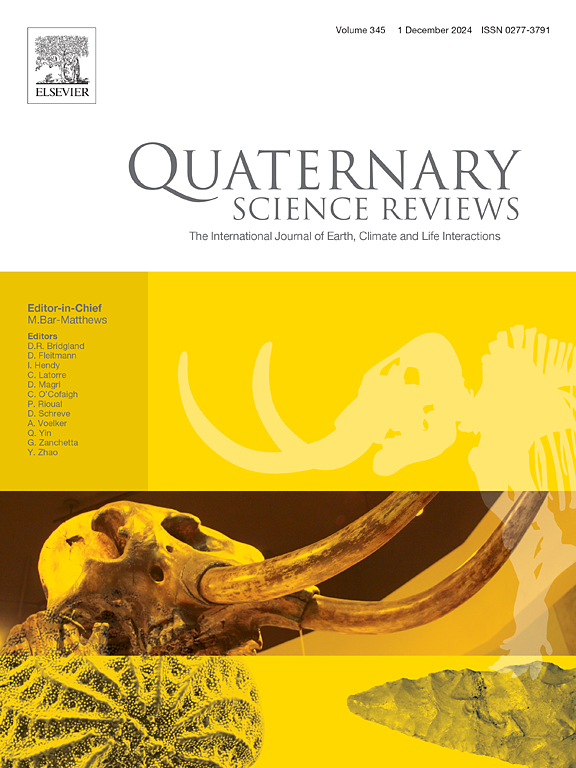全新世长江中下游古洪水回顾:过程、原因和影响
IF 3.2
1区 地球科学
Q1 GEOGRAPHY, PHYSICAL
引用次数: 0
摘要
人们对全新世长江中下游全流域洪水过程的认识仍然模糊不清。这主要是由于时空分辨率有限的遗址尺度数据所造成的限制,以及以往一些研究中重建全新世古洪水记录的结果相互矛盾。在本研究中,我们综合了 114 个具有可靠洪水发生证据(包括洪水发生的时间和地点)的古洪水数据,全面重建了第一个连续的全新世古洪水记录,该记录覆盖了整个多伦多河谷盆地。结果表明,在全新世开始时,长江中游(MRYR)的洪水频率明显达到峰值,而长江下游(LRYR)则没有观测到相应的峰值。然而,在长江中游和长江下游,大约在 8.0 ± 0.5 ka BP 出现了一个显著的洪水频率峰值,大约在 7.5-5.0 ka BP 出现了稀少的洪水。在 5.0-4.0 ka BP 期间,这种稀少的洪水频率突然转变为洪水频率的激增。在此之后,MRYR 的洪水频率连续出现了三次高峰,分别发生在大约 3.0 ka BP、1.8 ka BP 和 1.0 ka BP。相比之下,在 3.0-2.0 ka BP 期间,低海拔地区的洪水事件并不频繁,而从 2.0 ka BP 开始,洪水事件的频率急剧上升。我们进一步探讨了大洋中游地区古洪水的驱动机制,发现在大洋中游地区以潮湿和不稳定的气候条件为特征的EASM减弱时期更容易发生洪水。海洋侵蚀也可能是全新世早期缺乏古洪水地质证据的一个关键因素。此外,全新世晚期 ISM 的变化和人类活动也极大地影响了河套地区洪水的发生。通过比较古洪水发生频率与河套地区考古遗址的空间分布和数量,我们认为全新世中期洪水稀少时期可能促进了稻作农业的发展和古代聚落的繁荣。相反,在洪水多发期,古代社会通过在全新世早期向地势较高的地区迁移和在全新世晚期实施简单的水利工程技术来适应和应对洪水。本文章由计算机程序翻译,如有差异,请以英文原文为准。
A review of paleofloods in the middle-lower reaches of the Yangtze River during the Holocene: Processes, causes and effects
The understanding of the flooding processes in the entire basin of the middle-lower reaches of the Yangtze River (MLRYR) during the Holocene remains elusive. This is primarily attributed to the constraints posed by site-scale data characterized by limited spatiotemporal resolutions, compounded by conflicting results of the reconstructed Holocene paleoflood records in some of the previous studies. In this study, by synthesizing 114 paleoflood data with robust evidence of flood occurrence (including timing and location of flood occurrence), we comprehensively reconstructed the first continuous Holocene paleoflood record that cover the entire basin of the MLRYR. The results show that at the onset of the Holocene, flood frequency peaked notably in the middle reaches of the Yangtze River (MRYR), with no corresponding peak observed in the lower reaches of the Yangtze River (LRYR). However, in both the MRYR and LRYR, a significant flood frequency peak emerged around 8.0 ± 0.5 ka BP, and scarce flood occurrences appeared approximately 7.5–5.0 ka BP. This scarcity shifted abruptly to a surge in flood frequency from 5.0–4.0 ka BP. Following this, the MRYR witnessed three successive peaks in flood frequency, occurring at approximately 3.0 ka BP, 1.8 ka BP, and 1.0 ka BP, respectively. In contrast, flood events in the LRYR were infrequent during the 3.0–2.0 ka BP period, followed by a surge in frequency from 2.0 ka BP onwards. We further explored the driving mechanisms of paleofloods in the MLRYR and found that floods were more likely to occur during periods of weakened EASM, characterized by wet and unstable climate conditions in the MLRYR. Marine erosion may be also a key factor in the lack of geological evidence for palaeofloods during the early Holocene. Additionally, variations in the ISM and human activities during the late Holocene have significantly influenced the occurrence of floods in the MLRYR. By comparing the paleoflood frequency with the spatial distribution and number of archaeological sites in the MLRYR, respectively, we propose that the period of flood scarcity during the middle Holocene may have facilitated the development of rice agriculture and the prosperity of ancient settlements. In contrast, during flood-prone period, ancient societies adapted and coped with floods by migrating to higher terrain during the early Holocene and implementing simple hydraulic engineering techniques during the late Holocene.
求助全文
通过发布文献求助,成功后即可免费获取论文全文。
去求助
来源期刊

Quaternary Science Reviews
地学-地球科学综合
CiteScore
7.50
自引率
15.00%
发文量
388
审稿时长
3 months
期刊介绍:
Quaternary Science Reviews caters for all aspects of Quaternary science, and includes, for example, geology, geomorphology, geography, archaeology, soil science, palaeobotany, palaeontology, palaeoclimatology and the full range of applicable dating methods. The dividing line between what constitutes the review paper and one which contains new original data is not easy to establish, so QSR also publishes papers with new data especially if these perform a review function. All the Quaternary sciences are changing rapidly and subject to re-evaluation as the pace of discovery quickens; thus the diverse but comprehensive role of Quaternary Science Reviews keeps readers abreast of the wider issues relating to new developments in the field.
 求助内容:
求助内容: 应助结果提醒方式:
应助结果提醒方式:


